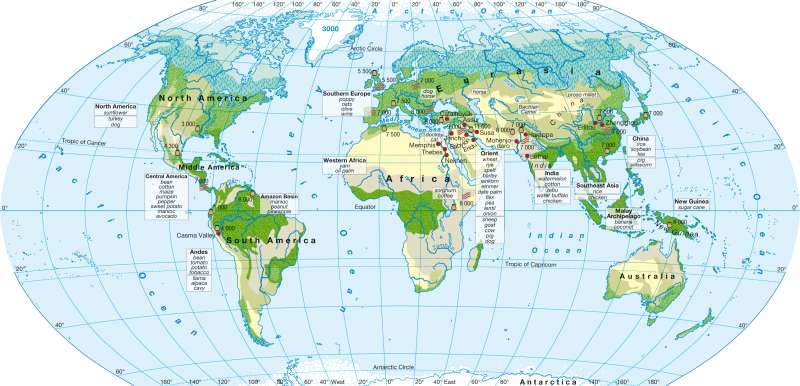Neolithic revolution and the beginnings of civilization
The world - Prehistory and early history
978-3-14-100790-9 | Page 180 | Ill. 2

Information
The bar chart shows the worldwide crop and meat production volumes in 2007. The main crops are maize, rice and wheat, with a harvest each year exceeding 600 million tons. The leader in food production is rice, with around 550 million tons, followed by wheat with approximately 430 million tons. Other important foods are potatoes and soybeans, each with approximately 220 million tons. In addition to cereals and oilseeds, fruits and vegetables provide the nutrition. Of the nearly 800 million tons of corn that were produced in 2007, only about 175 million tonnes were processed food; approximately 460 million tons were used as cattle feed and nearly 150 million tons for non-agricultural use. In addition to maize and wheat, potatoes, barley and rice are used as cattle feed.The main exporters of cereals in 2007 were the United States, Canada, the EU countries, Argentina, the Ukraine as well as Thailand (rice). About half of the feed grain exports in 2007 originated from the U.S., followed by Argentina, Australia and Canada. While corn, rice and wheat are grown worldwide, cultivation of barley, millet, sorghum, oats and rye is regionally grown.
In the livestock industry, the pig industry production represents more than 100 million tons of meat for the main branch, followed by chickens and cattle, with about 75 or 65 million tons of meat. The livestock industry of sheep, turkeys, ducks, geese and goats, produces relatively small quantities of meat.
Growing demand for agricultural products
With the growth of world population there is increasing demand for food and therefore agricultural products. While global food production in recent decades during the "Green Revolution" has grown faster than world population, in the next few years they will no longer be able keep pace with population growth. At the same time, per capita share of farmland is reducing: Accounted for (in 1960) each person on average, 0.44 hectares of arable land, in 2003 it was only half; in 2025 there will be only 0.17 hectares. In addition, growing shares of harvests are being used as animal feed or as an agricultural commodity. To produce a kilogramme of meat from an animal fed with cattle fodder, 323 square metres of land are needed; the production of one kilogramme of pork or chicken takes about 55 square metres of land, one kilogramme of vegetables and potatoes, only takes about six square metres. Of growing importance is the use of agricultural products as biofuel, as well as raw material for the chemical industry. Crops such as maize, which can serve both as food and as a base for biofuels, due to higher profits are being increasingly used for fuel production. In this way, in 2007 and 2008 approximately 100 million tonnes of cereal have been withdrawn from food markets.
H. Kiegel; Ü: C. Fleming




